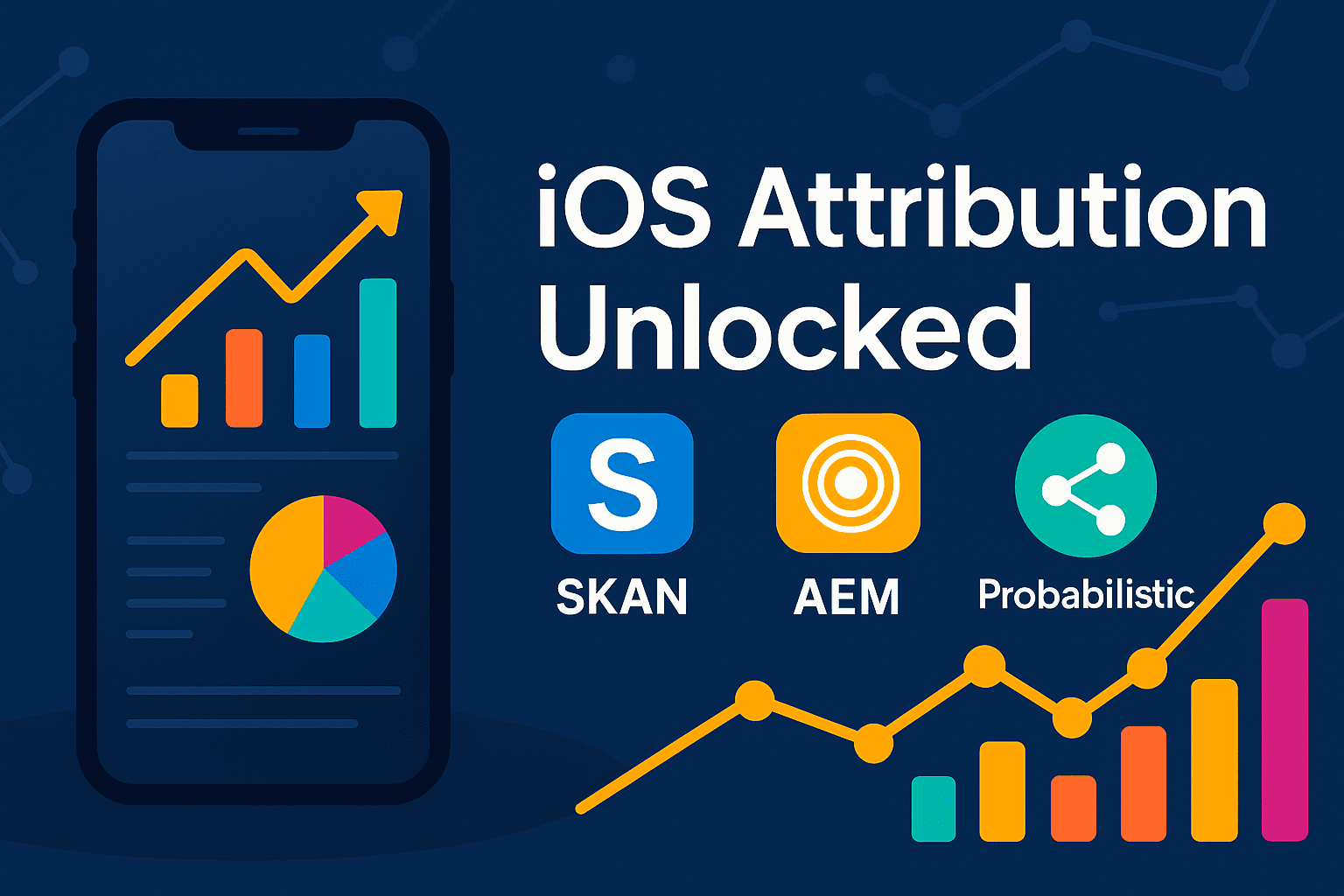iOS Attribution Unlocked: Navigating SKAdNetwork, AEM & Probabilistic Models

TL;DR:
SKAdNetwork ensures privacy but comes with delayed, sparse reporting; probabilistic models deliver fast, but modeled estimates; blending both signals gives you the speed and accuracy needed to optimize iOS UA campaigns.
In the post-IDFA world, measuring user acquisition on iOS has become a balancing act between privacy compliance and actionable insight. When Apple made IDFA opt-in, many sophisticated deterministic signals disappeared overnight. Today’s MMPs largely act as analytics dashboards for ad-network postbacks, rather than independent attribution providers. In their place, SKAdNetwork (SKAN) rose to prominence, offering 100% privacy-compliant attribution, but with multi-day delays and data sparsity. To regain visibility, major ad platforms introduced probabilistic attribution layers that infer installs in real time, at the cost of statistical uncertainty.
This guide breaks down each approach, compares the four biggest modeling protocols, and walks you through two frameworks: Single-Channel Uplift Analysis and Four-Layer Data Blend, that turn fragmented signals into clear, data-driven decisions.
Why Traditional Attribution Broke
Until early 2021, IDFA (Identifier for Advertisers) powered near-perfect, real-time iOS attribution. Marketers could track every click and install, tie revenue back to individual ads, and optimize campaigns minute by minute. Then Apple’s AppTrackingTransparency mandate flipped the switch:
SKAdNetwork Limitations
- Delayed reporting: Postbacks can take up to 41 days to fully arrive.
- Data sparsity: Smaller budgets or niche campaigns may never hit higher-tier postback thresholds.
- Under-reporting: SKAN often under-reports installs compared to App Store Connect by 5–15%.
Learn more: Apple SKAdNetwork Documentation
These constraints leave UA teams flying blind for days or weeks. Without in-flight visibility, pausing underperforming ads or scaling winners in time becomes nearly impossible.
The Rise of Probabilistic Attribution
To fill SKAN’s gaps, MMPs and ad networks unleashed probabilistic models that stitch together device signals, click timestamps, and campaign metadata:
Statistical inference:
Algorithms evaluate patterns across millions of anonymized events to infer likely installs.
Real-time feedback:
Get modeled install counts and event data within hours, perfect for rapid iteration.
No spend floors:
Even low-budget tests show “modeled” conversions, unlike SKAN’s tiered thresholds.
Probabilistic Benefits & Caveats
- Immediate insights: React to campaign trends in near real time.
- Consistent volume: No missing days of data.
- Modeled uncertainty: These are estimates - expect 10–30% variance vs. SKAN.
Pro tip: Always use probabilistic numbers to guide early optimizations, then validate and adjust with your deterministic SKAN roll-up.
Spotlight on Major Modeling Protocols
While branding differs, all major platforms blend first-party data with statistical models to infer iOS conversions:
Platform | Protocol | Core Mechanics |
|---|---|---|
Meta | AEM (Aggregated Event Measurement) | Aggregates events server-side with differential privacy techniques. Does not rely on SKAN. |
TikTok | ADC (Advanced Dedicated Campaigns) | Enhances SKAN signals by layering on TikTok’s own matching and weighting algorithms. |
Modeling Conversions + On-Device | Leverages Firebase SDK data and on-device hashing to probabilistically attribute conversions. | |
Snapchat | Advanced Conversions | Provides near real-time conversion estimates (≤36 hr delay) using Snap’s proprietary probabilistic models. |
Use this table as a quick reference, but remember: accuracy and variance differ by network and by app vertical.
Framework 1: Single-Channel Uplift Analysis
Ideal for lean teams running on a single ad channel:
- Establish a baseline
Track your daily trials, installs, or subscriptions before launching paid campaigns. - Run a controlled campaign
Keep all other marketing activities constant to isolate impact. - Measure the uplift
Subtract baseline volume from total during the campaign to find net conversions. - Compute real CPA

- Estimate LTV
Use historical user-value curves to project profitability at 30/60/90 days. - Decide to scale
If your real CPA sits comfortably below projected LTV, ramp up; otherwise, refine or pause.
Example:
- Baseline trials: 700/week
- Meta AEM reports: 500 trials
- Actual total trials: 1,400
- Uplift: 1,400 – (700 + 500) = 200 extra trials
- Combine that uplift with the 500 reported conversions to calculate your true cost per trial.
Framework 2: Four-Layer Data Blend for Multi-Channel
For companies juggling multiple ad networks, isolate truth with a four-layer blend:
- Collect the four metrics:
- Blended: Actual conversions from your backend (e.g., subscription server)
- SKAN: Deterministic postbacks (delayed)
- Modeled: Sum of all network-reported conversions
- Organic baseline: Pre-campaign trends
- Blended: Actual conversions from your backend (e.g., subscription server)
- Calculate an Adjustment Factor (AF):

- Apply AF to Modeled data:
Adjust each channel’s numbers to approximate SKAN-validated reality. - Use a decision matrix:
- If SKAN shows ROI → safe to scale.
- If Adjusted & Modeled agree on profitability but SKAN lags → test carefully.
- If only Modeled is green → suspect over-attribution.
- If Blended drives ROI (organics dominating) → prioritize assets that boost organic growth.
- If SKAN shows ROI → safe to scale.
This layered approach blends immediacy with determinism, giving you both speed and accuracy.
Conclusion: Orchestrating Attribution Signals
No single signal, whether deterministic SKAN, modeled conversions, or blended actuals can deliver the whole truth on its own. Think of your data sources as instruments in an orchestra:
- SKAN is the reliable bass line: slow but steady.
- Modeled attribution is the brass section: loud and attention-grabbing, but prone to embellishment.
- Blended actuals are your percussion: the ultimate ground truth driving the beat.
By harmonizing these elements using the frameworks above, you’ll turn the cacophony of conflicting reports into clear, actionable insights.
Glossary
- IDFA: Identifier for Advertisers (opt-in iOS tracking ID)
- SKAN: Apple’s SKAdNetwork attribution framework
- AEM: Meta’s Aggregated Event Measurement protocol
- CPA: Cost Per Acquisition
- LTV: Lifetime Value
